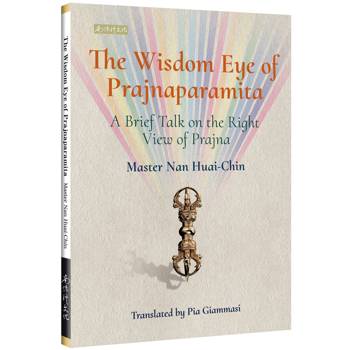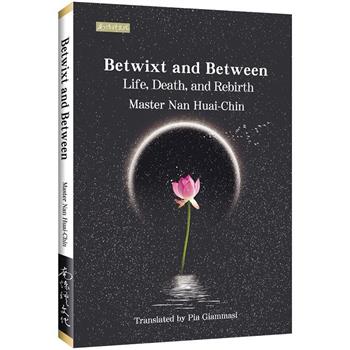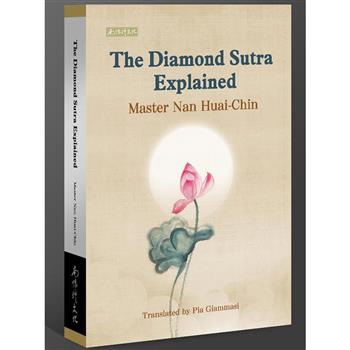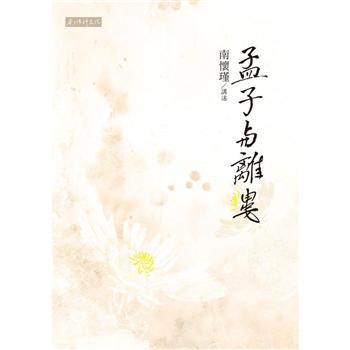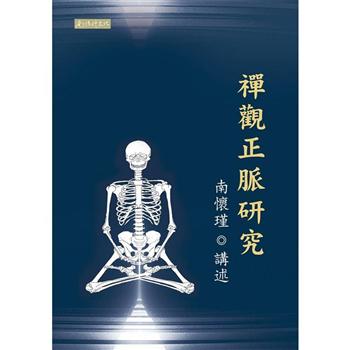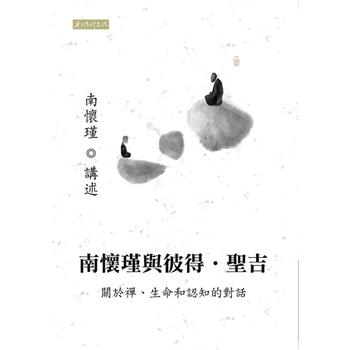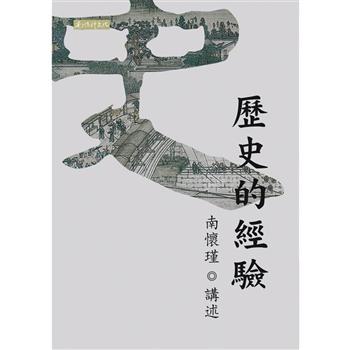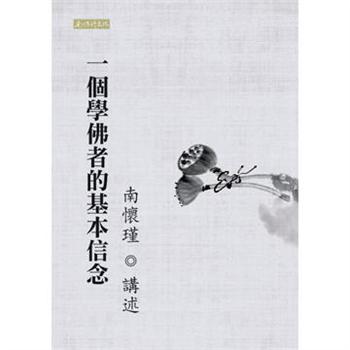新書
The wisdom eye of prajnaparamita: a brief talk on the right view of prajna
“Emptiness” is an experience that many people have had—mostly stumbled upon unexpectedly. What exactly is emptiness? Can it actually be practiced? The Heart Sutra is the shortest, most condensed teaching on emptiness among all of the Prajanaparamita Sutras, seems to be focused exclusively on emptiness. How can this sutra be used to help you progress in your spiritual practice? Ultimately, the realization of the heart of prajnaparamita is, in and of itself, the Path.In this book, you will read about how to use the Heart Sutra as a compact guide to practice and the Path. Master Nan’s teachings are packed with pith instructions, both the do’s and don’ts, for success in practice. Practical, to the point, and illustrated with thought-provoking anecdotes, his teachings are relevant to practitioners of all proclivities, from beginners to advanced.◎代理經銷:白象文化更多精彩內容請見http://www.pressstore.com.tw/freereading/9786269769582.pdf
【電子書】The wisdom eye of prajnaparamita: a brief talk on the right view of prajna
“Emptiness” is an experience that many people have had—mostly stumbled upon unexpectedly. What exactly is emptiness? Can it actually be practiced? The Heart Sutra is the shortest, most condensed teaching on emptiness among all of the Prajanaparamita Sutras, seems to be focused exclusively on emptiness. How can this sutra be used to help you progress in your spiritual practice? Ultimately, the realization of the heart of prajnaparamita is, in and of itself, the Path.In this book, you will read about how to use the Heart Sutra as a compact guide to practice and the Path. Master Nan’s teachings are packed with pith instructions, both the do’s and don’ts, for success in practice. Practical, to the point, and illustrated with thought-provoking anecdotes, his teachings are relevant to practitioners of all proclivities, from beginners to advanced.◎代理經銷:白象文化更多精彩內容請見http://www.pressstore.com.tw/freereading/9786269769582.pdf
【電子書】The wisdom eye of prajnaparamita: a brief talk on the right view of prajna
“Emptiness” is an experience that many people have had—mostly stumbled upon unexpectedly. What exactly is emptiness? Can it actually be practiced? The Heart Sutra is the shortest, most condensed teaching on emptiness among all of the Prajanaparamita Sutras, seems to be focused exclusively on emptiness. How can this sutra be used to help you progress in your spiritual practice? Ultimately, the realization of the heart of prajnaparamita is, in and of itself, the Path.In this book, you will read about how to use the Heart Sutra as a compact guide to practice and the Path. Master Nan’s teachings are packed with pith instructions, both the do’s and don’ts, for success in practice. Practical, to the point, and illustrated with thought-provoking anecdotes, his teachings are relevant to practitioners of all proclivities, from beginners to advanced.◎代理經銷:白象文化更多精彩內容請見http://www.pressstore.com.tw/freereading/9786269769582.pdf
雲山萬里:南懷瑾先生紀念輯
◎完整系統地展現南懷瑾先生傳奇一生◎據大量歷史資料編寫,力求客觀真實◎首次公開了大量史料,從先生「濟世利他重實行」的行履進而窺見「欲為天心喚夢醒」的願力。南懷瑾先生,一九一八年生於浙江省樂清縣,幼承庭訓,少習諸子百家。一生行跡奇特,常情莫測;四處奔波,化育無數。出版有儒、釋、道等各家五十多種著述,以其獨到的方式,引領新世代的人們直入文化的核心智慧,讓讀者更樂於瞭解歷史人文的博大精深。先生二〇一二年辭世,享年九十五歲。先生辭世後,上海恆南書院啟用。二〇二三年,書院為紀念先生一百零五週年誕辰設「雲山萬里——南懷瑾先生紀念展」,並在此基礎上編印紀念冊,以六大篇章完整系統展現先生的生平、行誼、學問、思想等方面,並首次公開了大量墨寶、通信、圖片等歷史資料,冀望有意瞭解、學習、研究的讀者,從先生「濟世利他重實行」的行履進而窺見「欲為天心喚夢醒」的願力。秋風落葉,掃之還來。本書闕漏謬誤之處,懇祈各方不吝指正。◎代理經銷:白象文化更多精彩內容請見http://www.pressstore.com.tw/freereading/9786269769568.pdf
南禪七日:生命科學與禪修實踐研究(上下冊)
◎一九九四年禪修活動文字紀錄首次公開發行。◎據錄音錄影逐字校修,真實還原講課情境。◎本書內容未經南師審定,為眾學友同好共同編輯而成,謬誤或所難免,也請各方不吝指正。一九九四年二月,南懷瑾先生應廈門南普陀寺住持妙湛老和尚之邀,於寺內新落成之禪堂舉辦禪修活動,定名為「生命科學與禪修實踐研究」。此次活動海內外參加者眾,活動內容並曾剪輯為錄影帶出版發行,名曰《南禪七日》,流傳廣泛,影響深遠。 七天之中,南師融匯顯密,貫通三家,結合佛法與科學,以禪定實修為主旨,從生命的法則講起,詳釋靜坐與安般法門,配合《瑜伽師地論》的學理,介紹禪宗、中觀與唯識,最後以修證了義的《楞嚴經》作結。理事並重,深入淺出,為有志身心修養的學人提供了一條真修實證的道路。 本書內容未經南師審定,為眾學友同好共同編輯而成,供有意了解當年活動的讀者參考,謬誤或所難免,也請各方不吝指正。
【電子書】南禪七日:生命科學與禪修實踐研究(上下冊)
◎一九九四年禪修活動文字紀錄首次公開發行。◎據錄音錄影逐字校修,真實還原講課情境。◎本書內容未經南師審定,為眾學友同好共同編輯而成,謬誤或所難免,也請各方不吝指正。一九九四年二月,南懷瑾先生應廈門南普陀寺住持妙湛老和尚之邀,於寺內新落成之禪堂舉辦禪修活動,定名為「生命科學與禪修實踐研究」。此次活動海內外參加者眾,活動內容並曾剪輯為錄影帶出版發行,名曰《南禪七日》,流傳廣泛,影響深遠。 七天之中,南師融匯顯密,貫通三家,結合佛法與科學,以禪定實修為主旨,從生命的法則講起,詳釋靜坐與安般法門,配合《瑜伽師地論》的學理,介紹禪宗、中觀與唯識,最後以修證了義的《楞嚴經》作結。理事並重,深入淺出,為有志身心修養的學人提供了一條真修實證的道路。 本書內容未經南師審定,為眾學友同好共同編輯而成,供有意了解當年活動的讀者參考,謬誤或所難免,也請各方不吝指正。
【電子書】南禪七日:生命科學與禪修實踐研究
◎一九九四年禪修活動文字紀錄首次公開發行。◎據錄音錄影逐字校修,真實還原講課情境。◎本書內容未經南師審定,為眾學友同好共同編輯而成,謬誤或所難免,也請各方不吝指正。一九九四年二月,南懷瑾先生應廈門南普陀寺住持妙湛老和尚之邀,於寺內新落成之禪堂舉辦禪修活動,定名為「生命科學與禪修實踐研究」。此次活動海內外參加者眾,活動內容並曾剪輯為錄影帶出版發行,名曰《南禪七日》,流傳廣泛,影響深遠。 七天之中,南師融匯顯密,貫通三家,結合佛法與科學,以禪定實修為主旨,從生命的法則講起,詳釋靜坐與安般法門,配合《瑜伽師地論》的學理,介紹禪宗、中觀與唯識,最後以修證了義的《楞嚴經》作結。理事並重,深入淺出,為有志身心修養的學人提供了一條真修實證的道路。 本書內容未經南師審定,為眾學友同好共同編輯而成,供有意了解當年活動的讀者參考,謬誤或所難免,也請各方不吝指正。
【電子書】Old Sage, New Robes:A Fresh Perspective on the Confucian Analects
Confucius’ students included political advisors, military strategists, educators, businessmen, philosophers, warlords, and kings. How could he possibly teach his way so calmly and gracefully through states and kingdoms of hegemons vying for regional power? Who was this man!?This is a book by two masters, one ancient and one contemporary, both enigmatic. The lives of Confucius and Master Nan Huai-Chin (Nan Huaijin), in many ways, parallel each other. Both lived through tumultuous times, both had to leave their home state and wander only to return in old age to their birthplace. They were teachers, learned in many fields and arts and in life itself, but not scholars in the traditional sense; rather, they were masters of all they engaged in. They had students from all walks of life, were advisors of statesmen of all ranks and were flanked by loyal followers. They both seamlessly wove together the worldly and the spiritual. And both were most concerned about the decline of people’s virtue, the deterioration of the culture, and of the general order of society. I believe this is why Master Nan could go beyond the words of the ancient texts to see the man who spoke them, to understand the events of those ancient times, and to grasp the significance of his life’s work.
Old Sage, New Robes: A Fresh Perspective on the Confucian Analects
Confucius’ students included political advisors, military strategists, educators, businessmen, philosophers, warlords, and kings. How could he possibly teach his way so calmly and gracefully through states and kingdoms of hegemons vying for regional power? Who was this man!?This is a book by two masters, one ancient and one contemporary, both enigmatic. The lives of Confucius and Master Nan Huai-Chin (Nan Huaijin), in many ways, parallel each other. Both lived through tumultuous times, both had to leave their home state and wander only to return in old age to their birthplace. They were teachers, learned in many fields and arts and in life itself, but not scholars in the traditional sense; rather, they were masters of all they engaged in. They had students from all walks of life, were advisors of statesmen of all ranks and were flanked by loyal followers. They both seamlessly wove together the worldly and the spiritual. And both were most concerned about the decline of people’s virtue, the deterioration of the culture, and of the general order of society. I believe this is why Master Nan could go beyond the words of the ancient texts to see the man who spoke them, to understand the events of those ancient times, and to grasp the significance of his life’s work.
Betwixt and Between: Life, Death, and Rebirth
This book is a record of a series of informal talks by Master Nan for Mr. Hu and others. The explanation starts from death, and continues until birth, all in terms of the normal human life cycle. 《Betwixt and Between: Life, Death, and Rebirth》is a record of Master Nan’s talks in which he answered questions about the process of death and rebirth. Master Nan weaves together personal anecdotes, scientific knowledge, Buddhist teachings from the Pali Canon, Mahayana sutras, Yogacara, Vijnanavada, and Chan in such an intricate way that those who are curious about the Buddhist perspective on life and death, those familiar with Buddhist teachings, and those who are deep into cultivation will all gain new insights and answers. For its depth, this book is very engaging and hard to put down. Any reader will find it to be a treasure trove and will want to come back to it again and again.
【電子書】Betwixt and Between: Life, Death, and Rebirth(人生的起點和終站)
This book is a record of a series of informal talks by Master Nan for Mr. Hu and others. The explanation starts from death, and continues until birth, all in terms of the normal human life cycle. 《Betwixt and Between: Life, Death, and Rebirth》is a record of Master Nan’s talks in which he answered questions about the process of death and rebirth. Master Nan weaves together personal anecdotes, scientific knowledge, Buddhist teachings from the Pali Canon, Mahayana sutras, Yogacara, Vijnanavada, and Chan in such an intricate way that those who are curious about the Buddhist perspective on life and death, those familiar with Buddhist teachings, and those who are deep into cultivation will all gain new insights and answers. For its depth, this book is very engaging and hard to put down. Any reader will find it to be a treasure trove and will want to come back to it again and again.
【電子書】Betwixt and Between: Life, Death, and Rebirth(人生的起點和終站)英文版
This book is a record of a series of informal talks by Master Nan for Mr. Hu and others. The explanation starts from death, and continues until birth, all in terms of the normal human life cycle. 《Betwixt and Between: Life, Death, and Rebirth》is a record of Master Nan’s talks in which he answered questions about the process of death and rebirth. Master Nan weaves together personal anecdotes, scientific knowledge, Buddhist teachings from the Pali Canon, Mahayana sutras, Yogacara, Vijnanavada, and Chan in such an intricate way that those who are curious about the Buddhist perspective on life and death, those familiar with Buddhist teachings, and those who are deep into cultivation will all gain new insights and answers. For its depth, this book is very engaging and hard to put down. Any reader will find it to be a treasure trove and will want to come back to it again and again.
【電子書】The Diamond Sutra Explained
This beautiful Sutra can be a compass and a gauge when journeying towards understanding our true selves. 【本書簡介】 Diamond Sutra Explained Master Nan Huai-Chin’s discourses on the treasured Buddhist Diamond Sutra bring together a lifetime of personal cultivation experience which ran the gamut of esoteric and spiritual practices. This beautiful Sutra can be a compass and a gauge when journeying towards understanding our true selves. Master Nan guides us through the Diamond Sutra providing students with a framework that combines understanding with practical cultivation. Master Nan’s teachings are unique among contemporary and historical interpretations.
【電子書】The Diamond Sutra Explained(金剛經說甚麼)英文版
This beautiful Sutra can be a compass and a gauge when journeying towards understanding our true selves. 【本書簡介】 Diamond Sutra Explained Master Nan Huai-Chin’s discourses on the treasured Buddhist Diamond Sutra bring together a lifetime of personal cultivation experience which ran the gamut of esoteric and spiritual practices. This beautiful Sutra can be a compass and a gauge when journeying towards understanding our true selves. Master Nan guides us through the Diamond Sutra providing students with a framework that combines understanding with practical cultivation. Master Nan’s teachings are unique among contemporary and historical interpretations.
The Diamond Sutra Explained
This beautiful Sutra can be a compass and a gauge when journeying towards understanding our true selves. 【本書簡介】 Diamond Sutra Explained Master Nan Huai-Chin’s discourses on the treasured Buddhist Diamond Sutra bring together a lifetime of personal cultivation experience which ran the gamut of esoteric and spiritual practices. This beautiful Sutra can be a compass and a gauge when journeying towards understanding our true selves. Master Nan guides us through the Diamond Sutra providing students with a framework that combines understanding with practical cultivation. Master Nan’s teachings are unique among contemporary and historical interpretations.
孟子與離婁
南懷瑾先生講述,承上啟下貫通孔孟思想、仁道精神的《孟子》〈離婁〉篇。 ◎從〈離婁〉這一篇開始,是《孟子》的下半部,等於是《孟子》上半部思想的延續發揮。想要真正瞭解孟子,瞭解他繼承孔子的思想,延續中國傳統的文化、政治哲學,其精神就在下半部的幾篇裡。 ◎春秋戰國的諸侯,個個都很聰明,但是歷史上擾亂世界,擾亂人類,也都是第一流聰明的頭腦。聰明沒有經過道德的薰陶、學問的培養,沒有用,這是重點所在。所以這一篇特別提出聰明的道理。 ◎聰明伶巧不足以作為領導的修養,高明必須要中庸,道德要渾厚。至於政治的權術,孟子說「徒善不足以為政,徒法不能以自行」,後世每一個開創的帝王,都懂孔孟的仁政並不是呆板的仁義思想。再加上一個最重要的道德修養,就是孟子的密宗。 本書為南懷瑾先生講述的《孟子》〈離婁〉篇。 《孟子》的前三篇〈梁惠王〉〈公孫丑〉〈滕文公〉,是孟子周遊諸侯國,與帝王之間談話的記述。從〈離婁〉這一篇開始,孟子已經回家教學生,不想動了。他同孔子一樣,對時代覺得沒有希望,為了挽救戰國末期那個時代,所以到處遊說教導諸侯,卻發覺救不了,他只好把自己的理想,轉向去培養下一代的學生,希望後輩挽救這個社會、國家、天下。所以他回去講學了,同孔子的精神是一樣的。〈離婁〉這一篇開始,就是在講學階段,由學生記錄下來。 《孟子》一書的整個精神,都以《春秋》責備賢者的立場為出發點。因此,他效法孔子的「祖述堯舜、憲章文武」的精神,在歷史的使命上,對於當時許多有權力的領導人的不當作為,就負起了責備的責任。 尤其在〈離婁〉這一章中,大部份講的是「君道」,就是一個領導人的基本道德修養,在上的真正聰明,不但是自己有頭腦,大臣的幫忙更要有力,這一切都是以道德為中心,要做到仁,也要做到孝。 接著也談到了「臣道」,負有行政責任的高官厚祿者,作人處世的道理;乃至「師道」,學術文化的修養,以及如何擔負人類所賦與的職責。 再進一步,又說明君臣之間,老闆與夥計之間,大家相處關係的重要性。一路討論下來,是首尾呼應,互相關照到全篇的大文章。
禪觀正脈研究
南師於本書揭示了《禪祕要法》在修持上的奧祕,為行者提供了切實的指引。 ◎原刊載於1982年~1983年之《知見》雜誌,1986年初次在台印行,2022年重新整理出版。 ◎除內文段落重新排版編輯,及修正部分錯漏字外,《禪祕要法》經文亦根據佛教出版社及《大藏經》之版本再次校對標點,以方便讀者閱讀。 佛法佛學越發達,證果的人卻越來越少,原因是什麼? 《禪祕要法》包涵了十念法門,以白骨觀入手起修,教我們如何解脫五陰,真正證果。一千多年來,這本經典卻被認為是小乘修法,不被重視。 根據佛陀的教導,及南師積數十年之體驗,不淨觀與白骨觀是最好的修持法門之一,佛弟子中,很多是修此二觀而迅速證果。但後世修行者,大都忽略此二法門,證果的人自然越來越少。 白骨觀和不淨觀,可破除身見,破除對這個身體的執著。色聲香味觸等五欲,乃至很多念頭,都是以這個身體為基礎的。安那般那、白骨觀兩大甘露法門,是先轉化四大,轉化習氣,因為這個業報之身轉了,才容易得到禪定,解脫身心。 《禪祕要法》這部經典,包括了佛法顯密各種的修持。從白骨觀開始,繫心一緣,再轉入安那般那,念出入息;之後再轉入修火觀,四大觀等等,也就是西藏密宗所講的修氣、修脈、修明點、修拙火的道理。 這些工夫做好了以後,再重新做一個整體真正念佛法門的修持,身心齊了,方為佛法真正修持之路。
南懷瑾與彼得.聖吉:關於禪、生命和認知的對話
南師與西方管理學大師暢談傳統文化、生命科學和認知科學,以及安那般那的實際修行方法。 ◎2003~2005 年南師與彼得.聖吉博士的對談紀錄。 ◎詳細解說生命的三種氣,「長養氣,報身氣,根本氣」。 ◎2021年新校版,修正部分錯漏字與經典原文。 聖吉博士一行,多年來鍥而不捨地研習中華文化,聖吉的著作,曾被《紐約時報》評為十年中最具影響力者。由種種跡象顯示,聖吉是站在時代的前端,他的努力似乎引導著西方文化的行進,更突顯出東西文化匯流的趨勢。這對人類文化而言,頗具積極意義,也是可喜的現象。 南師在書中說道: 今天的東西方,基本是唯物觀點發展的,同唯心觀點是分開的,認為心物是矛盾,搞得全世界茫然地活著。其實兩個是統一的。因為第一、二次工業革命,工商業發展,科技文明進步,西方人自己也迷糊了。現在是第三次精密科技的產業革命,更嚴重了。將來他們會回轉來,所以我希望你(聖吉)先學會,站在前面等他們。 佛告訴你,修安那般那首先要有個認識,生命的氣,大原則分三種:「長養氣,報身氣,根本氣」。現在你們打坐修道,呼吸即使到最細,完全止息了,仍然是在長養氣中搞,還沒有認得胎兒時那個生命本身的元氣。 所以要先了解風、喘、氣、息,乃至不呼不吸,完全到止息,幾乎恢復到胎兒時的那個情況,才認識到真正生命需要的那個原來的元氣。 要認識了生命裡那個本元之氣,才開始叫作真正修禪定做工夫;才能控制這個生命,才能轉變生命,才能進一步認識生命。在認識生命以後,才進入到後面還有的那個能量,那個能量姑且叫氣,在佛學裡叫作「種子氣」,相似於現在量子物理學所講的那個最後最後的東西……
歷史的經驗
南懷瑾先生開講,既不從學術立場來討論歷史,更無所謂學問,卻更能贏得讀者們的會心思忖。 ◎ 2021年重新校修版,引用原文重新校對,註解部分也替換為其他字體,以方便讀者閱讀。 ◎以《長短經》和《戰國策》,來講解謀略的大原則。 ◎不從學術立場來討論歷史,卻更能贏得讀者們的會心思忖。 南師懷瑾先生在一九七五年,受邀對文史團體「恒廬」,隨興講了一些歷史上的人事變遷和因果轉化,演講記錄整理出版後廣受歡迎。經過多次整理與再版,此次對書中的人、事、年代等,重加修訂,引用原文也重新排版檢校,以酬讀者們的愛護與支持。 〈反經〉的「反」字,意思就是說,天地間的事情,都是相對的,沒有絕對的。沒有絕對的善,也沒有絕對的惡;沒有絕對的是,也沒有絕對的非。天地間的人情、事理、物象,沒有一個絕對固定不變的。宇宙間的萬事萬物,隨時隨地都在變,立場不同,觀念就兩樣。因此,有正面一定有反面,有好必然有壞。譬如一個人春風得意,得意就忘形,失敗的種子已經開始種下去了;當一個人失敗時,所謂失敗是成功之母,未來新的成功種子,已經在失敗中萌芽了,重要的在於能不能把握住成敗的時間機會與空間形勢。 真正懂了其中道理,知道了宇宙萬事萬物都在變,第一等人曉得要變了,把住機先而領導變;第二等人變來了跟著變;第三等人變都變過了,他還在那裏罵變,其實已經變過去了,而他被時代遺棄而去了。〈反經〉的原則就在這裏。 就《戰國策》中〈蘇秦始將連橫〉和〈張儀說秦王〉這兩篇來進行研究。蘇秦、張儀當時的動機,是以自己個人的功名富貴為出發點,而把整個的國際局面,歷史的時代,在他們兩位同學的手裏擺布了約二三十年。他們並沒有一個中心思想,或政治上的主義。整個國際局勢就受蘇秦這樣一個書生的擺布,安定了二十多年,這又是一個什麼道理?為什麼他後來主張合縱,大家會團結?這是矛盾的團結,利害關係的團結,不是道義的團結。為什麼會這樣,也是值得我們研究的。為什麼孟子到處講仁義,到處吃癟?為什麼蘇秦、張儀會那麼吃香?我們讀了蘇秦、張儀兩人的傳記資料,瞭解了他們當時的歷史,拿來比較今天,就知道今天有如何的困難。
一個學佛者的基本信念
上座修觀以前,在這一念上先修普賢十大行願,然後萬緣放下,一念清淨,如此沒有不成功的。 ◎普賢行願品的修法是修學一切佛法的基礎,南師學佛,也是從此開始。 ◎修普賢行願觀想是一種事實,不只是理想、幻想,因為普賢菩薩的行願之力無所不在。 ◎隨時隨地修習普賢廣大圓滿行,從身口意三業起修,如此大小乘的戒定慧都在其中。 本書為南懷瑾先生於民國七十四年(西元一九八五年)元月在十方禪林寒假共修會的講稿整理,今日重校重刊,機緣難得! 學佛修行第一步要從普賢行願開始,三世一切諸佛之所以能夠成就佛果,全在圓滿了普賢行願。 「普賢」即是「普現」,憑藉普賢如來的威神力加被,一念真誠清淨便到了。一一佛菩薩前面都有我,坐在這裡,眼閉著也可以,另一念的身體出去禮拜,有無量百千萬億的化身,一念之間就出去了。 以普賢菩薩廣賅無盡三千大千世界虛空般的行願力為榜樣,方是真修行人,才是真佛子,如果真能徹徹底底從心中熱切地生起普賢菩薩大行大願的情操來,便能突破多生累劫來的罪障惡業,那麼迅速成就菩提道果,夫復何疑! 所有十方世界一切準提佛母之前,一切如來之前,都有我在恭敬頂禮,這是普賢如來的行願力,哪一位是普賢如來呢?就是你——自性的普賢! 凡是真實發心修習大乘佛道的人,首先要熟讀《普賢行願品》。當念習純熟以後, 要深思它的意義與意境,擴大自己的心量,培養自己的願力與心境。


